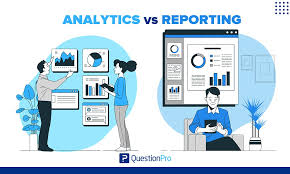
The Power of Analytics: Unleashing Insights for Business Success
In today’s data-driven world, analytics plays a crucial role in helping businesses make informed decisions, optimize processes, and drive growth. By leveraging the power of data analysis, organizations can uncover valuable insights that lead to improved performance and competitive advantage.
Analytics involves the discovery, interpretation, and communication of meaningful patterns in data. Through various techniques such as statistical analysis, predictive modeling, and data mining, businesses can extract actionable intelligence from their vast datasets.
Benefits of Analytics in Business
- Improved Decision-Making: Analytics provides businesses with valuable insights that enable informed decision-making based on data rather than intuition.
- Enhanced Efficiency: By analyzing operational data, organizations can identify inefficiencies and streamline processes for greater productivity.
- Targeted Marketing: Analytics helps businesses understand customer behavior and preferences, allowing them to tailor marketing strategies for better engagement and conversion.
- Risk Management: Through predictive analytics, companies can anticipate potential risks and take proactive measures to mitigate them.
The Role of Data Visualization
Data visualization is a key component of analytics that transforms complex datasets into easily digestible visuals such as charts, graphs, and dashboards. Visual representations help stakeholders grasp trends, patterns, and outliers at a glance, facilitating faster decision-making and communication of insights.
Challenges in Analytics Implementation
While the benefits of analytics are clear, organizations often face challenges in implementing effective analytics strategies. Common hurdles include data quality issues, lack of skilled personnel, inadequate technology infrastructure, and resistance to change within the organization.
The Future of Analytics
As technology continues to evolve rapidly, the future of analytics holds exciting possibilities. Advancements in artificial intelligence (AI), machine learning, and big data processing are poised to revolutionize how businesses harness the power of analytics for competitive advantage.
In conclusion, analytics is not just a tool for analyzing historical data; it is a strategic asset that empowers businesses to innovate, adapt to market dynamics, and stay ahead of the competition. By embracing analytics-driven decision-making processes, organizations can unlock new opportunities for growth and success in today’s fast-paced business landscape.
Understanding Analytics: Purpose, Examples, Benefits, Functions, Definitions, and Types
- What is the purpose of analytics?
- What are examples of analytics?
- What are analytics good for?
- What data analytics do?
- What do you mean by analytics?
- What are the 4 types of analytics?
What is the purpose of analytics?
The purpose of analytics is to extract meaningful insights from data that can drive informed decision-making, optimize processes, and improve overall business performance. By applying various analytical techniques to raw data, organizations can uncover patterns, trends, and correlations that provide valuable intelligence for strategic planning and operational efficiency. Analytics enables businesses to gain a deeper understanding of their operations, customers, and market dynamics, ultimately empowering them to make data-driven decisions that lead to competitive advantage and sustainable growth.
What are examples of analytics?
Analytics encompasses a wide range of applications across various industries, showcasing its versatility and impact. Some common examples of analytics include predictive analytics used in forecasting sales trends, customer behavior analysis in marketing to tailor personalized campaigns, operational analytics to optimize supply chain management, and sentiment analysis on social media to gauge public perception. Financial institutions utilize risk analytics to assess creditworthiness, while healthcare organizations leverage healthcare analytics for improving patient outcomes and operational efficiency. These examples illustrate the diverse ways in which analytics can be applied to drive informed decision-making and achieve business objectives.
What are analytics good for?
Analytics serves a multitude of purposes in various industries, making it a versatile and invaluable tool for businesses. From enhancing decision-making processes to optimizing operations, analytics offers insights derived from data analysis that can drive strategic initiatives and improve overall performance. By leveraging analytics, organizations can gain a deeper understanding of customer behavior, identify trends, forecast outcomes, mitigate risks, and ultimately achieve a competitive edge in today’s data-driven landscape. Whether it’s improving marketing campaigns, streamlining supply chain operations, or enhancing product development strategies, analytics plays a pivotal role in unlocking actionable intelligence that fuels business success.
What data analytics do?
Data analytics plays a crucial role in extracting valuable insights and patterns from vast datasets to aid in informed decision-making and strategic planning. By utilizing statistical analysis, predictive modeling, and data mining techniques, data analytics helps businesses uncover trends, identify opportunities, mitigate risks, and optimize processes. Whether it’s understanding customer behavior, improving operational efficiency, or enhancing marketing strategies, data analytics empowers organizations to leverage their data assets for competitive advantage and business success.
What do you mean by analytics?
Analytics refers to the systematic computational analysis of data to extract valuable insights, patterns, and trends that can inform decision-making and drive business strategies. In essence, analytics involves the exploration of data through various techniques such as statistical analysis, predictive modeling, and data mining to uncover meaningful information that can help organizations optimize processes, understand customer behavior, mitigate risks, and achieve competitive advantages. By leveraging analytics, businesses can transform raw data into actionable intelligence, enabling them to make informed decisions based on evidence rather than intuition.
What are the 4 types of analytics?
In the realm of analytics, there are four primary types that play distinct roles in extracting insights from data: descriptive analytics, diagnostic analytics, predictive analytics, and prescriptive analytics. Descriptive analytics focuses on summarizing historical data to provide a clear understanding of past events. Diagnostic analytics delves deeper into why certain outcomes occurred by analyzing patterns and relationships in the data. Predictive analytics uses statistical algorithms and machine learning techniques to forecast future trends and outcomes based on historical data. Lastly, prescriptive analytics goes a step further by recommending actions to optimize decision-making processes based on the insights generated from the other types of analytics. Each type serves a unique purpose in guiding businesses towards informed decisions and strategic planning.
